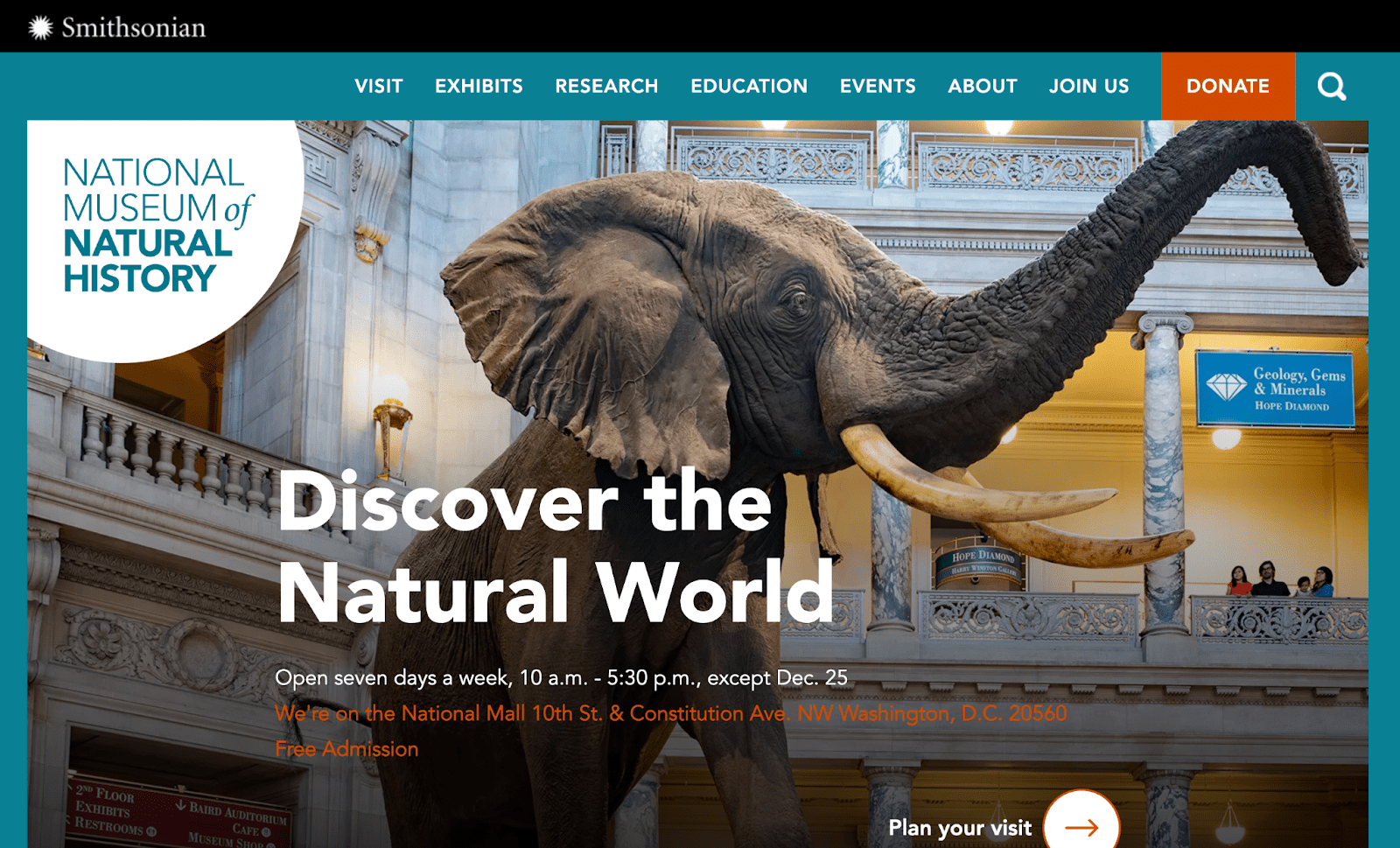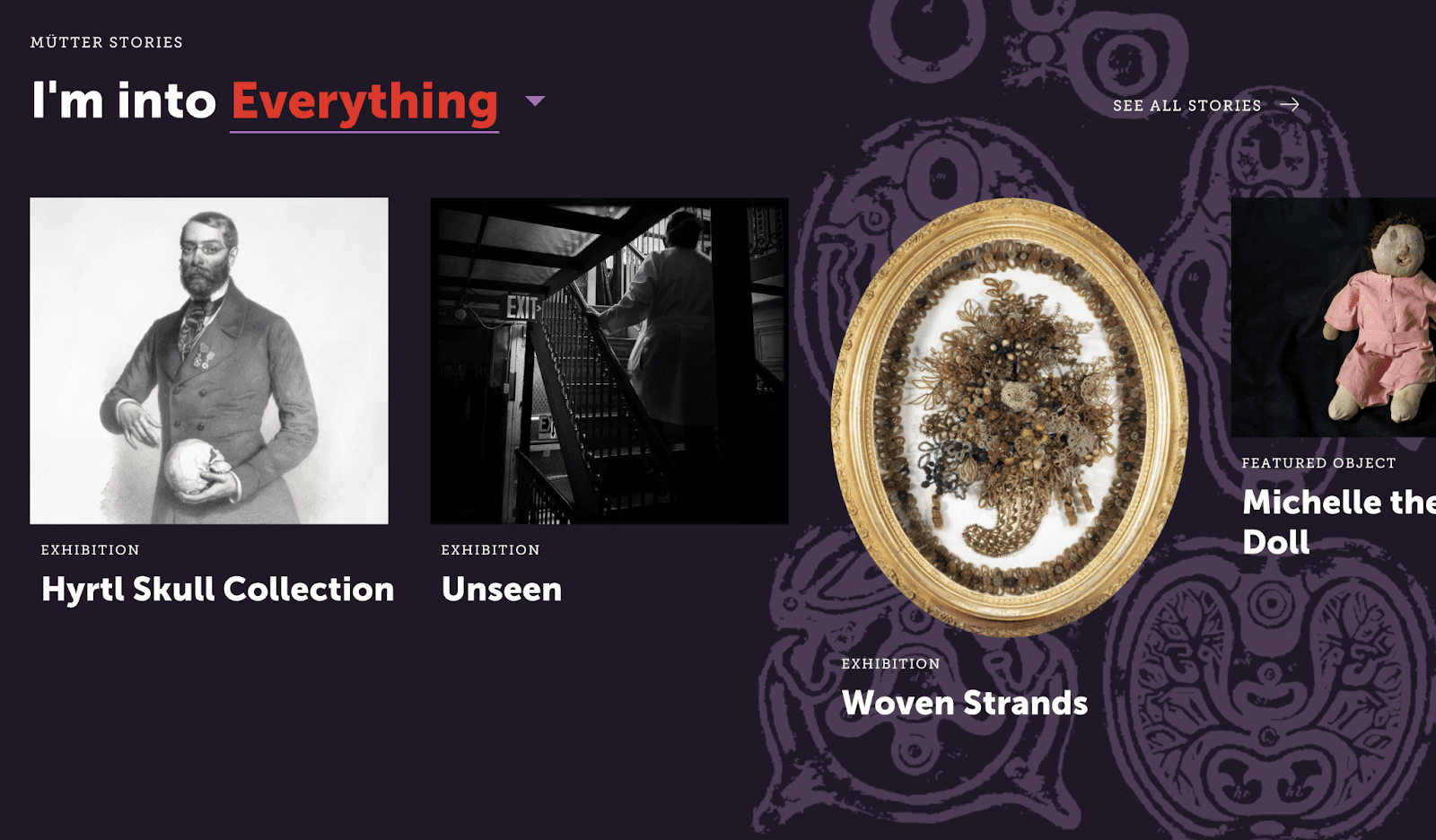Increase Visits with Content Marketing for Museums
- 8 Tips for Content Marketing for Museums
- 1. Curate a vibe with your homepage
- 2. Create dedicated pages for new exhibits
- 3. Use social media challenges to earn user-generated content
- 4. Tell 'behind the scenes' stories
- 5. Video, video, video
- 6. Start a podcast
- 7. Give people things to do on your website
- 8. Create a blog and email series
- Let's get to work
Few institutions were hit as hard by Covid as museums. And while there’s been a long, slow recovery since 2021, overall attendance remained down by 38% last year, and 17% of directors were still worried about the risk of closing permanently.
The key to recovery lies in a lesson learned during 2020: the necessity of going digital. But it’s been a struggle. While the majority of museum professionals recognize the need to invest in digital content creation and new methods of marketing management, only 21% of museums have full-time staff dedicated to digital activities.
The difficulty is particularly acute for smaller to mid-sized organizations: only about half of these museums have online exhibitions or learning programs. 10% of small museums aren’t even on social media.
That’s why in 2023 every museum’s mission should include cultivating your online presence. A great museum website is an extension of the museum itself — a sort of digital antechamber where people can begin to learn about your subject before they even walk in the door.
Here are eight ideas for content that will increase your web traffic and, as a result, your foot traffic.

8 Tips for Content Marketing for Museums
1. Curate a vibe with your homepage
Chances are before someone visits your museum, they’re going to visit your website. That means your page is their first impression – and you know what they say: you only get one chance.
That’s why your site should help convey what it feels like to be there. Websites don’t just list information; they make us feel something – about a brand, about an institution, about ourselves as patrons or visitors. They let us know what the museum feels like inside.
Consider the homepage for the Smithsonian Institute’s National Museum of Natural History. The first thing you see is a photo of Henry, the 11-ton 13-foot tall elephant in their rotunda, dwarfing a group of visitors admiring it from the balcony.

It’s a great photo on its own, but think about what it gives the website visitor:
- A taste of something remarkable that needs to be seen in person to be truly experienced.
- A glimpse of the museum’s architecture, showing that the location itself is interesting on its own.
- A hint at the unforgettable experience we’ll have when we visit.
All of these elements compel you to plan a trip in person. Videos, photos, and thoughtful design will all help pique people’s interest in your institution before they even set foot in the door.
2. Create dedicated pages for new exhibits
A common tip for optimizing search engine results for museums is to create separate pages for each of your products or services. This way you create search engine-friendly results that lead back to your website.
The same goes for museums. Don’t just let an “About” page explain everything you have at your museum. Create a unique page for each major exhibit so you can provide more information and media content to get people excited.
For instance, The Mote Marine Laboratory and Aquarium has over a dozen different online exhibits that showcase their aquatic fauna, promote in-person attractions, and educate online visitors. Big Sea partnered with Mote to redesign their website in order to boost engagement and better inform visitors about opportunities to donate, volunteer, and get involved. In the process, we designed custom exhibits for the site – such as “Otters and Their Waters” – that people love to link to. (Otter-cam, anyone?)
Individual exhibit pages add value to your site by giving people more to explore. Ultimately the site becomes as useful and revisit-worthy as the museum itself.
3. Use social media challenges to earn user-generated content
If your Facebook news feed looked anything like ours in 2020, you might remember a trend from the early days of Covid: people were recreating famous paintings at home using themselves and household objects – and sometimes their pets! – as props.

The idea started with a small instagram account called “Between Art and Quarantine,” but it really took off when the Getty Museum in Los Angeles picked up on it and promoted the trend on social media as the #GettyChallenge. Even better – they wrote a blog about it for the website that showed off the results.
A successful hashtag campaign like this doesn’t just get your name out there. It gets people engaged and having fun online. It harnesses user-generated content to help you draw in new followers. And it encourages people to find out more about your subject. Getty encouraged people to reference works from their own online collection, driving more traffic to their site and subtly reminding people where they could see all these works in person once lockdown was lifted.
4. Tell “behind the scenes” stories
One way to help people connect to your institution is to give them a peak behind the scenes. If people feel like they’re part of your organization, they’ll be more enthusiastic about patronizing and promoting it.
Think about something like fantasy football (weird jump, I know, but stay with me): fantasy football encourages fans to imagine themselves as managers of teams. It gets them thinking about game statistics, about players on other teams, about high-level decisions about how organizations get run. There are lots of interesting conversations and unseen processes going on.
Behind-the-scenes info about your museum can serve a similar role. Post updates about acquiring new objects for the museum. Show people what it’s like to work there. Answer questions like: what’s a typical day like for a curator or a tour guide? What’s unique about the work that has to happen in advance before an exhibition is displayed to the public? Testimonials and video diaries can go a long way toward building engagement.
For inspiration, here are nine museums with video web series that invite patrons to learn more about all the work that goes into their exhibitions. If producing these videos seems like a lot, it is! But don’t worry. While video is the gold standard for online engagement, you don’t have to have your own Netflix series to draw people in. Do video if you can, but any regular updates on your site – ideally with lots of illustrations and photos – will get folks pumped up.
On that note, we should mention…
5. Video, video, video
The idea of producing video content of any kind can feel really daunting. But smart phones open up a world of possibilities for creating short-form video content that’ll be a massive draw for your organization.
Short-form videos (like the kind you see on Tik Tok or on Instagram reels) have become some of the most effective content formats on social media. 70% of viewers report that an intriguing YouTube video inspired them to check out a brand in more depth. Over 70% of users report that video is their preferred way to learn about an organization
So break out your smart phone and start recording! Post some short interviews (we’re talking 60 seconds here) with people who work at the museum. Do a quick walk through to show what the place is like. It doesn’t have to be great right away. Practice will make perfect. Look up any YouTube influencer, scroll back a few years, and you’ll find early videos that were nowhere near as sophisticated as what they’re making now. The sooner you dip your toes in the water, the sooner you’ll be swimming like a champ.
6. Start a podcast
If video feels like too much work, you can always start a podcast! Who would have thought 20 years ago that radio shows would become an exciting new 21st century medium? But they have. And the hurdles toward getting started are minimal and easy to jump.
The International Spy Museum (you’re interested already, aren’t you?) has a weekly podcast interviewing authors, historians, and public officials. Subjects can range from broad overviews of cyber security or Cold War history to very specific topics such as “Baseball and Espionage” or “Honey Trapped: Sex, Betrayal, and Love.”
The podcast is hosted by the museum’s historian and curator, but not every episode relates to something actually on exhibit. Instead, the podcast generates interest in the museum just by its existence. Someone who’s interested in espionage might have never known there was a museum dedicated to it in Washington, DC, until they stumbled upon this podcast one day while Googling.
And that’s the goal. Producing a podcast can cultivate a whole new audience for your museum and generate newfound interest from your current patrons.
7. Give people things to do on your website
Your website can be so much more than a “come to our museum” pitch. It can be its own destination for interactive learning and exploration – a natural extension of your museum’s mission. The words, images, and activities on your website can supplement the material you have at your museum and provide patrons with a way to extend their visit virtually to increase their engagement.
For instance, The Mütter Museum in Philadelphia has displayed rare and unusual medical specimens since it opened in the 19th century as a physicians’ training ground. Today it houses a collection of 20,000 items and cultivates an eccentric fan following due to the quirky and morbid nature of the objects on display (the tallest human skeleton in North America, a collection of 139 human skulls, slivers of Albert Einstein’s brain, and a piece of thoracic tissue taken from the body of John Wilkes Booth, to name a few).

But wait – there’s more. The museum’s website features a section called Mütter@Home that hosts a wide array of interactive material such as quizzes, mini exhibits, and virtual tours. Not only does this content pique interest for potential visitors, it furthers the museum’s mission as an educational institution, and establishes their expertise and authority.
8. Create a blog and email series
Get back in touch with your inner LiveJournal-ist and start a blog! People like ‘em (heck, you’re reading one right now), and they get results. 77% of internet users read blogs, and businesses that blog produce about 67% more leads per month than businesses that don’t. We offer a deep-dive into lead generation with content marketing if you’re interested.
Your institution already offers a wealth of topics to write about so it’s easy to get started. Interview your curators about what they do and why it’s important. Give readers updates on new projects and more detailed background about your major exhibits. Great museum blogs give people a chance to dive deep into an area of interest and learn more about what’s going on behind the scenes.
As you write, try to hone in on keywords that amateur researchers might be hunting for in their own journey. Long-form articles with lots of photos (and maybe even an occasional video) will provide another path for people to find your site.
Once you start regularly producing new posts you can promote them with a dedicated biweekly email. But remember, this isn’t a “promotional” newsletter; it’s just a dedicated list interested in the research stories happening inside your institution.
Let’s get to work
Excellent content marketing shouldn’t feel like advertising at all. When you create things people genuinely like to read, watch, and click, they’ll find out how much they love what you do. They’ll become patrons and advocates for your organization.
At Big Sea, we create content that people love to engage with. Our museum marketing experts specialize in cultivating online engagement that brings people to your website and through your doors. Whatever your goals or your budget, we can’t wait to help expand your audience.

